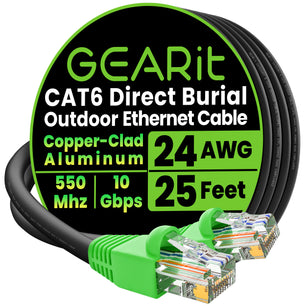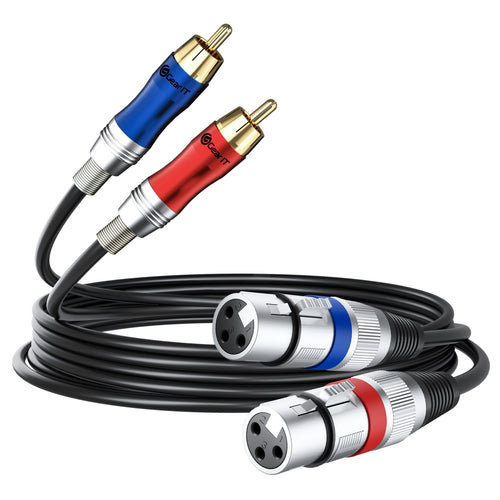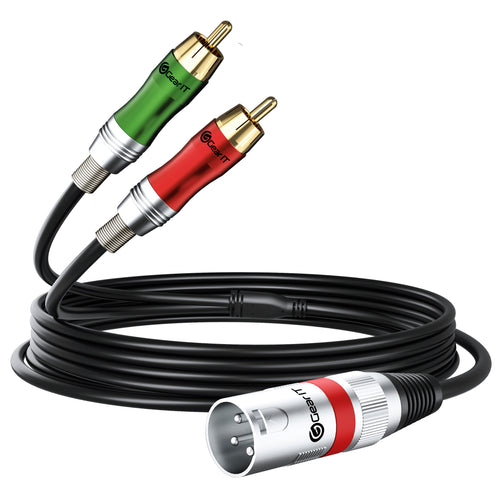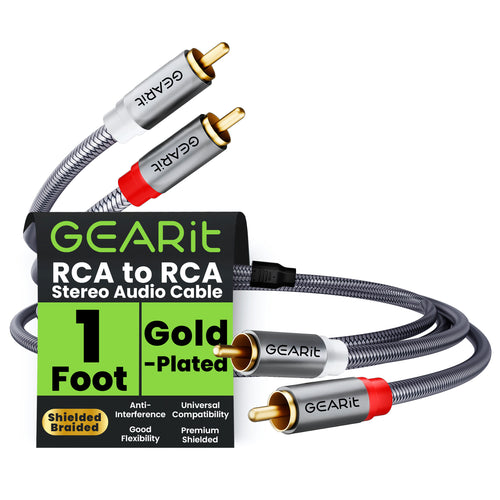RCA cables are essential for connecting audio and video devices like TVs, amplifiers, and sound systems. They provide a reliable analog signal for stereo audio and are still widely used for home theater setups and older equipment.
Upgrade your sound system with GearIT’s premium RCA cables:
Shop GearIT now for high-quality RCA cables that deliver clear, reliable audio connections! 🎶🔌

Have you ever connected your television to a DVD or CD player? If you have, then you likely used an RCA cable. They first appeared in audio technology during the mid-20th century, and today they remain a staple cable for in-home and professional uses. What exactly are these cables, and when and why would you need them? Learn more about the modern applications for RCA cables and how to find the best quality.
What Are RCA Cables?
The Radio Corporation of America was the first to use the RCA cable in the 1940s to connect phonographs and sound amplifiers. Today, this standard three-plug, color-coded line distributes video and audio from one device to another. The most commonly used types are composite video, component video, and digital audio cables.
Composite Video Cables
Composite video cables are the most recognizable. These carry standard-definition video signals from one device to another. They have three prongs on each end, one end being male and the other female. The different colors of each plug mark their intended use:
-
White and red carry the audio signals to the left and right speakers.
-
Black is sometimes a replacement for white and red, also carrying the audio signals.
-
Yellow carries the composite video signal.
Composite video cables are less prominent on the market than their modern counterparts. They are non-digital and carry all video data through a single signal, which can reduce the quality. Component videos provide a more sophisticated signal.
Component Video Cables
If you have a high-definition television, you may use a component RCA cable. It has five prongs on each end. The red, blue, and green lines carry video signals capable of a significantly higher resolution than the one analog line in a composite video cable. The audio lines are red and white or red and black, and the red audio and video prongs typically have one other color to distinguish one from the other.
Digital Audio RCA Cable
Composite and component cables carry analog signals. However, modern cables are capable of carrying digital signals. A digital audio stream has a broader bandwidth than an analog cable could carry. To accommodate that, it uses a coaxial cable with RCA connectors.
When and Why Would You Use RCA Cables?
Despite the growing popularity of HDMI cables, an alternate audio/visual cable used for HD-capable devices, there is still demand for an RCA cable in many applications. High-end digital cameras, stereos, and surround sound systems still use RCA jacks. The GearIT RCA Male to Male Stereo Audio Cables can transfer high-quality audio signals from an AV receiver to multiple types of equipment:
- Mixer
- DJ controller
- Home Hi-Fi system
- Amplifier
Surveillance systems, home theaters, audio recording equipment, gaming consoles, digital cameras, and camcorders all may make use of these cables. Most are inexpensive, with variances in cable length and capability being the primary factors impacting the cost.
Versatility keeps the RCA cable alive. It evolves with the updates in audio and video signals, with adaptations to accommodate higher bandwidth and limit interference. Some cables can even convert analog signals into digital to improve the quality of older devices connecting to more modern ones.
Additionally, these cables remain relatively universal, most able to connect to new and legacy equipment. For example, even the latest smart TVs have the standard two audio and one video RCA jacks.
What Affects the Quality of RCA Cables?
Several factors influence the quality of cables, including the materials, cable length, and type of shielding. While pricing is rarely a significant consideration because the average cost of an RCA cable is relatively low, understanding these factors aids in evaluating the quality and performance of the cable you purchase.
Wire Material
Cables with RCA connectors can come in several different types of metal. However, the top-tier cabling most commonly chosen for professional usage feature one of the following three materials:
-
Gold. The most expensive cables have gold wiring, a higher quality metal than silver or copper that is an effective conductor. Additionally, gold connectors are more resilient to oxidation, making them last longer.
-
Silver. Silver is better for electrical conductivity than gold. It performs well as a carrier for audio and video signals and is less expensive than gold.
-
Copper. Another excellent material for electrical conductivity is copper. You can find oxygen-free copper conductors, like this Dual XLR Female to Dual RCA Male cable, offering high ductility.
RCA cables may also use zinc, nickel, and tin wiring. These cables can be efficient as well, but gold, copper, and silver are generally superior.
Cable Length
The length of your RCA cable is a crucial consideration. Obviously, you want a line with adequate distance between your input and output devices. However, a shorter cable length can mean a little less degradation in a signal's transmission quality. When in doubt, go for a slightly longer cable, but overall, consider how you intend to use it.
Shielding
Shielding plays a significant role in performance quality. A well-shielded cable carries a better signal. A strong shield reduces interference, which can degrade the signal and corrupt data from one device to another. For example, this GearIT Y-Splitter XLR to RCA cable has spiral braided copper shielding and polyethylene insulation to reduce interference and insulate excess noise.
Read more about: What Makes The Best Coaxial Cable Splitter? (A Buying Guide)
How Do RCA Cables Differ From HDMI Cables?
HDMI and RCA differ in what signals they carry. HDMI carries both audio and video signals through a single plug, while RCA requires separate connectors.
Additionally, HDMI is all digital, while RCA is typically analog. However, as you know, modern RCA cabling can also carry digital signals. With advancements in RCA capabilities, an RCA cable can produce audio and video quality on par with HDMI.
Where Do You Get Quality RCA Cables?
All RCA cables are not created equal, but now you have the knowledge to make an informed decision about audio and video conductors, weeding out the low-quality materials and unshielded cables to find products that meet and exceed your performance needs. Start with a vendor specializing in audio/visual equipment. Check out GearIT's collection of top-performing cables online.



























































